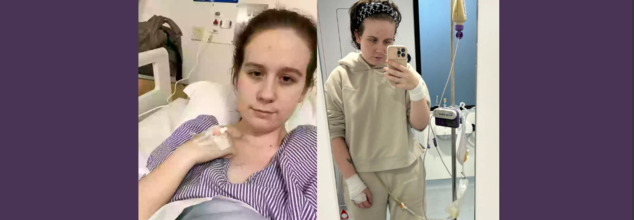
Image Credits: Canva
Can You Flush Out A UTI By Drinking More Water?
Urinary tract infections (UTIs) are among the most prevalent bacterial infection, which occurs in millions of people worldwide, especially females. Although antibiotics are still the mainstay treatment, hydration has an important place in prevention as well as recuperation. Can consuming more water, however, actually flush a UTI? Let's learn the science behind this popular suggested remedy.
A UTI is the result of bacteria, typically Escherichia coli (E. coli), entering the urinary tract and causing infection. Infection may involve the bladder (cystitis), urethra (urethritis), or even the kidneys (pyelonephritis). Women are more prone because their urethras are shorter, allowing easier access for the bacteria to reach the bladder.
Hydration is the key to the health of urinary tracts. Physicians often tell patients with UTIs to drink more water so that bacteria could be flushed out. Research, such as in JAMA Internal Medicine, established that women who drank an extra 1.5 liters of water per day had significantly less frequent UTIs than those consuming less water.
This is how water works to flush out UTI:
Dilutes Urine: Consumption of lots of fluids makes the urine less concentrated, thus preventing irritation to the bladder.
Frequent Urination: Increased intake of water leads to frequent urination, and this helps drain bacteria from the urinary tract prior to their growth.
Reduces Bacterial Adhesion: Water keeps the body in a position where bacteria do not stick to the bladder wall, hence lower chances of infection.
How Much Water Should You Drink?
Patients with UTIs are usually instructed to have a minimum of 6-8 glasses (1.5-2 liters) of water per day. The intention is to consume adequate fluid to generate clear urine and have a consistent flow.
But too much water can cause hyponatremia (water intoxication), in which sodium becomes abnormally low. One must balance and be hydrated but avoid overconsumption.
Symptoms of a UTI
Although UTIs may be symptomless, typical symptoms are:
- Frequent need to urinate
- Painful urination
- Frequent, small volumes of urine
- Cloudy or pungent urine
- Pelvic discomfort (in women)
- Red or pink-colored urine (indicating blood in the urine)
If you have fever, chills, or pain in the flank, it could be a sign of a kidney infection, which is an emergency.
Other Hydrating Foods and Beverages for UTI Relief
Aside from water, there are some foods and drinks that can aid urinary tract health:
Water-rich fruits: Watermelon, honeydew melon, and oranges add to the hydration.
Cranberry juice: Although studies are unclear, some studies indicate that unsweetened cranberry juice might prevent bacterial adhesion in the bladder.
Vitamin C-containing juices: Orange juice and lemon water can make urine more acidic, which is not a suitable place for bacteria to grow.
Herbal teas: Chamomile and ginger tea can provide soothing relief while maintaining hydration levels.
What to Avoid When You Have a UTI
Some fluids can make UTI symptoms worse and should be avoided:
Sugary beverages: Too much sugar encourages bacteria growth.
Alcohol and caffeine: Both of these irritate the bladder and can make symptoms worse.
Artificial sweeteners: In diet sodas and sugar-free products, these tend to make UTI symptoms worse.
Preventing UTIs
Drinking water works as a prevention, but certain lifestyle modifications may further minimize UTI risk:
- Urination following intercourse: Aids in expelling bacteria inserted during sex.
- Front-to-back wiping: Hinders the travel of bacteria from the anal area to the urethra.
- Avoidance of irritating feminine hygiene products: Douches, deodorant sprays, and perfumed hygiene products tend to disturb natural bacterial balance.
- Selecting the appropriate birth control: Spermicides and diaphragms can lead to bacterial overgrowth; use other methods of contraception.
When to See a Doctor
Though minor UTIs might clear up with more fluids, one needs to see a doctor if:
- Symptoms last longer than two days
- Blood is present in the urine
- Fever, nausea, or back pain (signs of a possible kidney infection)
- Recurrent UTIs despite preventive action
While drinking water will assist in flushing out bacteria from the urinary tract and help relieve mild symptoms, it is not a treatment by itself. Antibiotics are generally needed to effectively treat bacterial infection. A well-hydrated state remains an important part of both prevention and recovery, though. With added water consumption paired with good hygiene and lifestyle changes, you can greatly lower your chances of developing UTIs and improve the overall health of your urinary tract.

Credits: Canva
Is There A Link Between Chronic Pain And Depression?
Have you ever felt so tired that you had your joints aching, shaky hands, recurring headaches, and excessive weariness. Did you feel like you were just having a bad day and your body felt too tired? They are not only symptoms of a bad day. These are small but persistent symptoms of a larger problem: chronic pain. What is chronic pain? Pain that persists for more than three months is no longer considered transient or situational. It causes a condition that lowers not only one's physical health but also one's whole quality of life.
Chronic pain is a widespread issue, impacting nearly 30 percent of people globally. It can arrive slowly or after an injury, and once it settles in, it often refuses to leave. Over time, it can dull not just physical strength, but emotional resilience. The discomfort starts to bleed into other areas — your sleep, energy levels, social life, and mental well-being.
The Link Between Pain and Mood
It’s no surprise that ongoing physical pain can be emotionally draining. But recent research points to something deeper: a strong biological link between chronic pain and depression. When pain is felt in multiple areas of the body — known as multisite chronic pain — the risk of developing depression rises sharply. In fact, people with this type of pain are nearly four times more likely to experience depressive symptoms.
What makes this connection particularly important is that it’s not just psychological. New scientific methods have revealed that chronic pain and depression might share genetic roots. Inflammatory markers like C-reactive protein (CRP) — commonly elevated in those with ongoing pain — are also linked to mental health issues. In other words, the pain-depression link may not just be coincidental. It could be caused by underlying biological processes.
When Pain Spreads, So Does Its Impact
Not all types of pain affect mental health equally. Some forms — like facial pain, stomach pain, and chronic headaches — have been found to carry a stronger link to depression. As pain spreads across the body, the emotional toll deepens. It’s not just the pain that becomes unbearable — it’s the sense of being worn down physically and mentally, day after day.
Even simple tasks can become overwhelming. Chronic pain can make everyday actions feel exhausting, while also disrupting sleep and making recovery more difficult. The longer it lasts, the more likely it is to impact work, relationships, and overall identity.
Why Treating Pain Means Treating the Mind Too
One of the key takeaways from the research is that chronic pain and depression often need to be treated together. Focusing only on physical relief without addressing the emotional damage can leave recovery incomplete. Similarly, treating mental health without easing physical symptoms may not be effective.
The emerging mind-body approach encourages healthcare providers to look at both aspects — helping patients manage pain while also supporting their emotional well-being. Whether through therapy, lifestyle changes, medication, or a mix of all three, the goal is to offer holistic care that treats the whole person.
What You Should Know
- Pain in multiple areas raises the risk of depression. The more widespread the discomfort, the greater the emotional burden.
- Inflammation plays a role. Markers like CRP may explain the physical-mental connection.
- Genes can make a difference. Some people may be more genetically prone to both conditions.
- There may be causation, not just correlation. Advanced studies suggest that chronic pain might lead to depression biologically.
- Mind and body are connected. A comprehensive approach is essential to truly heal.

Credits: Canva
Diabetes Medication Millions Take May Be An Unexpected Protection From Blood Cancer
In an breakthrough scientific discovery, scientists have found that a common diabetes medication taken by millions globally—metformin, may provide unexpected protection against acute myeloid leukemia (AML), a fast-growing and frequently fatal type of blood cancer. This has been established by a new study by the University of Cambridge, which has been published in the highly-respected journal Nature. The study suggests metformin to be a low-cost, safe preventative therapy for individuals who are at high risk of developing AML.
This finding may represent a paradigm change in the approach to cancer prevention in medicine—particularly in hematological malignancies where early intervention is usually restrictive.
In contrast to solid cancers like breast or prostate cancer, which at times may be removed surgically, blood cancers are more difficult to localize and destroy. As Cambridge Stem Cell Institute Professor George Vassiliou describes it, "With blood cancers, we must first find people at risk and then apply medical treatments to halt cancer growth across the body." AML, which begins in the bone marrow and develops quickly, is an example of this difficulty.
Approximately 3,100 individuals in the UK are diagnosed with AML every year. It has a poor prognosis and few treatment options, especially in the elderly. Although the latest advances in blood testing are able to indicate individuals at risk years earlier than before, to date, there has not been a sure way to stop AML from forming.
How Diabetes Drug Interrupts Cancer Development at the Cellular Level?
Scientists targeted their research on DNMT3A, a gene commonly mutated in AML patients. This one mutation is thought to trigger as much as 15% of all AML. Metformin seems to break the energy metabolism of these pre-leukemic cells, targeting their aberrant growth pathways. By disabling the cells' capacity to produce energy, metformin stops them from developing into full-blown leukemia.
Additional analysis of health information from more than 412,000 UK Biobank participants reinforced the link. Metformin users had a significantly lower incidence of damaging mutations in the DNMT3A gene, whether or not they had diabetes. The results indicate a protective effect that is independent of the drug's initial purpose.
What is Metformi?
The origins of metformin trace back to medicinal plants used during medieval Europe. Isolated from Galega officinalis, a plant used in traditional medicine to cure urinary and metabolic problems, its active ingredient—guanidine—was discovered to lower blood sugar in the early 20th century. Although it was disfavored for a period, metformin was re-released and approved in Europe in the 1950s and subsequently by the FDA in 1995. It's now most commonly prescribed diabetes medication globally, especially in patients who have type 2 diabetes and are unable to regulate blood sugar levels by diet and exercise alone.
How Metformin Works?
Decreasing the level of glucose absorbed by the intestines through food.
Suppressing the liver's release of glucose.
Increasing insulin sensitivity, so that the body can utilize glucose more effectively.
These metabolic actions are not only helpful for controlling diabetes, but potentially for stopping or slowing other disease processes—such as cancer.
Benefits of Metformin
What's even more amazing is how metformin's benefits go beyond controlling blood sugar. According to Harvard Health and other medical centers, the medication has been linked with:
- Reduced cardiovascular mortality among diabetics
- Moderate weight loss
- Decreased risk for type 2 diabetes in persons with prediabetes
- Help with polycystic ovary syndrome (PCOS)
- Lower risk for cancers such as breast, colon, and prostate
- Possible diminishment of risk for dementia and stroke
Off-label prescriptions have also been used for some of these indications in metformin, highlighting the drug's versatile utility and solid safety profile.
One of the main advantages of metformin is its long history of safety. Taken by millions of people over many decades, it tends to have only minor side effects—e.g., nausea, bloating, or altered taste. Serious side effects, such as lactic acidosis, are infrequent and typically only occur in those with existing kidney disease.
As Blood Cancer UK's Director of Research Dr. Rubina Ahmed put it, "Repurposing existing, safe drugs such as metformin allows the possibility that new treatments might get to people earlier, without going through the extensive drug development pathways."

Credits: SWNS
At 27, This Woman Couldn't Urinate On Her Own For 6 Years Until She Got Diagnosed With A Rare And Painful Condition
Most of us, use the restroom is an effortless way, there is an urge to pee and so it is an easy, unconscious act. For 27-year-old Anna Gray from Bath, England, such a simple function was an impossible task—a task that defined her life for six long years! Diagnosed with Fowler's Syndrome, a rare and painful urinary disorder, Anna has spent more than a half-dozen years having to use catheters just to empty her bladder.
Anna's health emergency started in November 2018 when she was hospitalized with a severe kidney infection—brought on by not being able to urinate for several days. Physicians initially thought it was an isolated incident. But when her bladder had to be drained of almost two liters of urine and the issue continued, it was evident this was no typical infection.
Just weeks after that, another hospitalization uncovered something disturbing: Anna's bladder was not functioning at all. After invasive procedures, the reason still eluded her. Specialists eventually diagnosed her with Fowler's Syndrome—a condition so uncommon, even seasoned urologists had encountered only a handful of cases.
"I was informed there was nothing further that could be done," Anna remembered in an interview. "I couldn't comprehend how it could occur to me."
By 2020, after years of repeated infections and hospital stays, Anna was fitted with a suprapubic catheter—a tube inserted through her belly directly into her bladder. The catheter empties urine into a collection bag, which she has to empty several times a day.
"Coming to terms with this being my life now was really hard," she said. "There were mental health issues. I was in the hospital last year for depression."
In January 2024, Anna developed sepsis around her catheter site—a life-threatening complication that led to three weeks in intensive care. Yet despite the setbacks, she refuses to hide her condition.
“I wear shorts, tops—you can see the bag. It doesn’t bother me. People ask questions, and I’m fine with that.”
Because of the paucity of her condition, Anna first felt extremely isolated. "I felt like I was the only person in the world experiencing this," she said. But that ended when she learned about online support groups for Fowler's Syndrome patients.
"Meeting others who understood was life-altering. I finally didn't feel alone," said Anna.
Community support has become a lifeline for so many with chronic illnesses, especially those such as Anna whose conditions are under-recognized or misunderstood by the public and even the medical community.
Anna summed up, "I'm learning to live with it. I want people to know they're not alone. Even with a condition like this, life can still be full."
What is Fowler's Syndrome?
Initially identified in 1985, Fowler's Syndrome is an uncommon etiology of urinary retention in females, generally aged between 20 and 30 years. Fowler's Syndrome affects the urethral sphincter—the muscle that controls the release of urine—making the muscle remain constricted, even when the bladder is full. This leads to a lack of ability to urinate spontaneously.
In contrast to most other causes of urinary retention, Fowler's Syndrome is not associated with neurological disease. It may come on suddenly in some cases with no apparent cause. In others, it may follow surgery or delivery.
Symptoms of Fowler's Syndrome
Symptoms differ from patient to patient. Some may be able to urinate but not completely empty the bladder, while others—such as Anna—are completely retained. With the filling of the bladder, severe pain and frequent infection ensue. Many women experience recurring cystitis, kidney infections, and constant pain.
What Causes Fowler's Syndrome?
To this point, the true cause of Fowler's Syndrome has not been discovered. Scientists are still trying to determine why the urethral sphincter does not relax. Some speculations include hormonal connections, particularly because approximately 50% of patients also suffer from polycystic ovaries, yet no cause has been determined.
The syndrome could develop spontaneously or after surgery—most often gynecological or urological—or after delivery. Without an established cure, symptom management becomes the main priority.
Treatment for Fowler's Syndrome
Treatment of Fowler's Syndrome depends on severity.
Mild Cases: Patients with the ability to urinate partially might only require monitoring to assess residual bladder volume.
Moderate Cases: Those with high residual volumes might need intermittent self-catheterization several times a day to avoid infection and bladder damage.
Severe Cases: In complete retention cases, patients can be considered for sacral nerve stimulation—a treatment involving the use of electrical pulses to stimulate nerves and return bladder function. This is still the only treatment with hope of restoring natural urination in some patients.
© 2024 Bennett, Coleman & Company Limited

